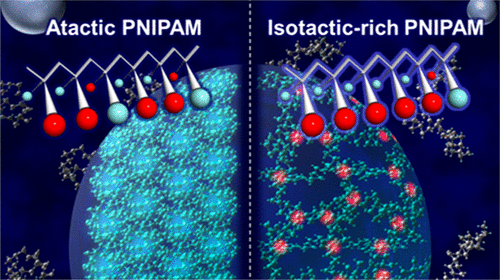当前位置:
X-MOL 学术
›
J. Phys. Chem. B
›
论文详情
Our official English website, www.x-mol.net, welcomes your feedback! (Note: you will need to create a separate account there.)
Microanalysis of Single Poly(N-isopropylacrylamide) Droplet Produced by an Optical Tweezer in Water: Isotacticity Dependence of Growth and Chemical Structure of the Droplet.
The Journal of Physical Chemistry B ( IF 3.3 ) Pub Date : 2020-09-08 , DOI: 10.1021/acs.jpcb.0c06932 Kenta Ushiro 1 , Tatsuya Shoji 1, 2 , Mitsuhiro Matsumoto 1 , Taka-Aki Asoh 1, 2 , Hideo Horibe 3 , Yukiteru Katsumoto 4 , Yasuyuki Tsuboi 1, 2
The Journal of Physical Chemistry B ( IF 3.3 ) Pub Date : 2020-09-08 , DOI: 10.1021/acs.jpcb.0c06932 Kenta Ushiro 1 , Tatsuya Shoji 1, 2 , Mitsuhiro Matsumoto 1 , Taka-Aki Asoh 1, 2 , Hideo Horibe 3 , Yukiteru Katsumoto 4 , Yasuyuki Tsuboi 1, 2
Affiliation

|
Thermoresponsive phase separation mechanisms of aqueous poly(N-isopropylacrylamide) (PNIPAM) solutions were investigated using an optical tweezer combined with a Raman microspectroscope. A near-infrared laser beam (λ = 1064 nm) was focused into the solution to produce and trap a single polymer microdroplet under an optical microscope. The laser beam played two important roles: The first role is to locally heat the solution to induce phase separation in which numerous polymer microdroplets are generated around the focus, while the second one is to collect these microdroplets. Eventually, a single polymer droplet was stably produced and trapped at the focus. Our method enabled us to perform two types of microanalysis for the droplet. Analysis I is real-time monitoring the growth of the polymer droplets by which we can determine the growth rate of droplets. Analysis II is Raman microspectroscopy to reveal chemical components of the droplets. By means of these two analyses, we revealed important phase separation mechanisms in terms of stereoregularity (isotacticity) dependence. From analysis I, we show that droplet growth is governed by the Ostwald ripening mechanism and the growth is accelerated by increasing the isotacticity. From analysis II, we show that the gelation is promoted in the droplet (physical gel formation) with increasing isotacticity. Our technique should be a versatile tool to explore liquid–liquid phase separation mechanisms for various binary solution systems.
中文翻译:

光学镊子在水中产生的单个聚(N-异丙基丙烯酰胺)液滴的微观分析:液滴的生长和化学结构等规度依赖性。
水性聚(N)的热响应相分离机理使用光学镊子和拉曼显微光谱仪研究了-异丙基丙烯酰胺(PNIPAM)溶液。将近红外激光束(λ= 1064 nm)聚焦到溶液中,以在光学显微镜下产生并捕获单个聚合物微滴。激光束起着两个重要作用:第一个作用是局部加热溶液以引起相分离,在该相分离中,在焦点周围会生成许多聚合物微滴,而第二个作用是收集这些微滴。最终,稳定地产生了单个聚合物液滴并捕获在焦点处。我们的方法使我们能够对液滴执行两种类型的微量分析。分析一是实时监控聚合物液滴的生长,由此我们可以确定液滴的生长速率。分析II是拉曼光谱,以揭示液滴的化学成分。通过这两个分析,我们从立体规则性(全同规整度)依赖性方面揭示了重要的相分离机制。从分析一中,我们表明液滴的生长受奥斯特瓦尔德(Ostwald)成熟机制的控制,并且通过增加等规度来加速液滴的生长。从分析II中,我们显示随着等规度的增加,液滴中的胶凝作用得到了促进(物理凝胶的形成)。我们的技术应该是探索各种二元溶液系统液-液相分离机理的通用工具。我们表明,液滴的生长受奥斯特瓦尔德(Ostwald)成熟机制的控制,并且通过增加等规度来加速液滴的生长。从分析II中,我们显示随着等规度的增加,液滴中的胶凝作用得到了促进(物理凝胶的形成)。我们的技术应该是探索各种二元溶液系统液-液相分离机理的通用工具。我们表明,液滴的生长受奥斯特瓦尔德(Ostwald)成熟机制的控制,并且通过增加等规度来加速液滴的生长。从分析II中,我们显示随着等规度的增加,液滴中的胶凝作用得到了促进(物理凝胶的形成)。我们的技术应该是探索各种二元溶液系统液-液相分离机理的通用工具。
更新日期:2020-09-24
中文翻译:

光学镊子在水中产生的单个聚(N-异丙基丙烯酰胺)液滴的微观分析:液滴的生长和化学结构等规度依赖性。
水性聚(N)的热响应相分离机理使用光学镊子和拉曼显微光谱仪研究了-异丙基丙烯酰胺(PNIPAM)溶液。将近红外激光束(λ= 1064 nm)聚焦到溶液中,以在光学显微镜下产生并捕获单个聚合物微滴。激光束起着两个重要作用:第一个作用是局部加热溶液以引起相分离,在该相分离中,在焦点周围会生成许多聚合物微滴,而第二个作用是收集这些微滴。最终,稳定地产生了单个聚合物液滴并捕获在焦点处。我们的方法使我们能够对液滴执行两种类型的微量分析。分析一是实时监控聚合物液滴的生长,由此我们可以确定液滴的生长速率。分析II是拉曼光谱,以揭示液滴的化学成分。通过这两个分析,我们从立体规则性(全同规整度)依赖性方面揭示了重要的相分离机制。从分析一中,我们表明液滴的生长受奥斯特瓦尔德(Ostwald)成熟机制的控制,并且通过增加等规度来加速液滴的生长。从分析II中,我们显示随着等规度的增加,液滴中的胶凝作用得到了促进(物理凝胶的形成)。我们的技术应该是探索各种二元溶液系统液-液相分离机理的通用工具。我们表明,液滴的生长受奥斯特瓦尔德(Ostwald)成熟机制的控制,并且通过增加等规度来加速液滴的生长。从分析II中,我们显示随着等规度的增加,液滴中的胶凝作用得到了促进(物理凝胶的形成)。我们的技术应该是探索各种二元溶液系统液-液相分离机理的通用工具。我们表明,液滴的生长受奥斯特瓦尔德(Ostwald)成熟机制的控制,并且通过增加等规度来加速液滴的生长。从分析II中,我们显示随着等规度的增加,液滴中的胶凝作用得到了促进(物理凝胶的形成)。我们的技术应该是探索各种二元溶液系统液-液相分离机理的通用工具。


























 京公网安备 11010802027423号
京公网安备 11010802027423号